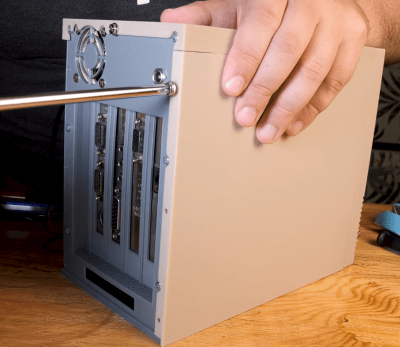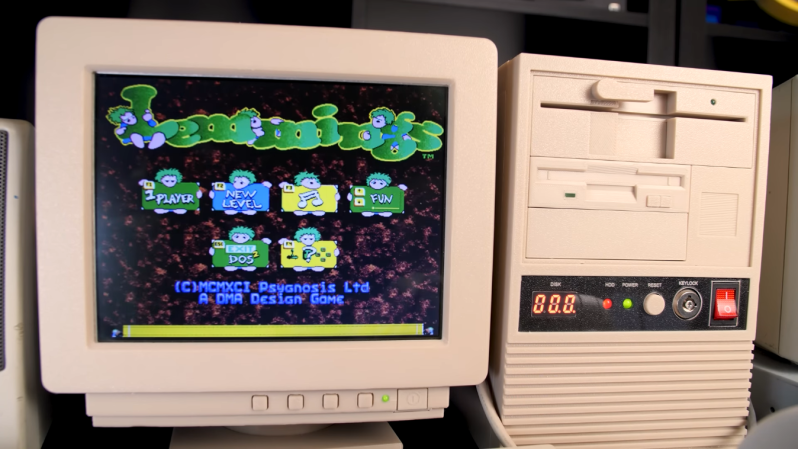Emulators are easy and convenient, but for some retrocomputing enthusiasts nothing comes close to running classic software on actual era-appropriate hardware. This can become a problem, though, for those into vintage PC gaming: old PCs and their monitors are notoriously large and heavy, meaning that even a modest collection will quickly fill up a decent family home. There is a solution however, as [The Eric Experiment] demonstrates in his latest video. He designed and built a 3D-printed mini PC that runs on an actual 486 processor.
An ordinary desktop motherboard would have required a rather large case to begin with, so [Eric] started his project by buying an old industrial PC board. Such a device has the processor and all main motherboard components sitting on an ISA card, which then connects to other ISA cards through a backplane. This way, a complete system with expansion cards can be made way more compact than even the sleekest desktop PCs of the time. An SD-card-to-IDE converter makes for an extremely slim hard drive replacement, while a Gotek floppy emulator allows the system to boot as if there’s actually a floppy drive present.

All of this is pretty neat to begin with, but by far the most impressive parts of the Tiny 486 project are the enclosures that [Eric] designed for the PC and its accompanying monitor. Both were modelled off real-world examples and are accurate down to the smallest details: the tilting stand that clips onto the base of the monitor for instance, or the moving latch on the faux 5.25″ floppy drive. That latch operates a cleverly hidden door that reveals the USB connector for the floppy emulator. The compulsory seven-segment LED display on the mini tower’s front panel now finally serves a useful purpose – indicating which floppy image is currently active.
Sporting an Intel 486-DX4 100 MHz processor, 32 MB of RAM, a Tseng ET4000 video card and an ESS Audiodrive for sound, the tiny 486 can run DOS or Windows 95, although performance in the latter is a bit limited due to the lack of a local-bus video card. It’s perfectly fine for most DOS games though, and a lot more practical than a full-sized desktop PC.
There are several ways to make a tiny game PC, like using PC/104 standard boards or repurposing old network equipment. The crucial part needed to turn it into a gaming machine is a proper sound card, which you can even build from scratch if needed. Thanks for the tip, [Nathan]!
















The Title Photo needs a banana for scale.
Shut up and take my money!
Really? DOOM NOT tested?
This can run Quake just fine too. Missed opportunity.
Not really. 486 with ISA graphics means 1-4 fps.
That’s a bit of an understatement, I believe. It depends on several factors, such as speed of ISA bus (overclocked yes/no?), amount of external cache, CPU cache (write back or write through), DOS memory managers (V86 yes/no?), 486 CPU generation (has VME yes/no?) etc.
My humble 286 16MHz (10 MHz ISA bus) and an OAK-067 has 10fps in Superscape Benchmark 1.0c (uses VGA mode 13h at 320×200 256c).
A 486 is not a 486. They go from 16 MHz to 100 MHz, with Pentium Overdrive CPUs being available, too.
The 486DX2-66 was a classic, in the same hall of fame as the 386DX-40, the 286-12 or those 8MHz Turbo XTs with NEC V20s.
*Typo. 10 MHz 286, I meant. The bus runs at CPU speed in that PC of mine.
What’s also important, the type of VGA graphics card model and its revision.
Some models like ET-4000 have a FiFo buffer than can make better use of ISAs limited bandwith.
That’s why the ET-4000 was well supported by the demoscene, for example.
Then there are later models with VBE in BIOS or 2D accelerator functions (useful for GUIs).
On the downside, the late models like ET-4000/W32 had lost emulation modes for CGA/EGA/MGA and hi-res text-modes that could be enabled via mode utility.
The old models also had device drivers available for GEM3, Windows 2.x, Orcad, Generic CAD, OS/2 v1.x and so on.
That’s when you realize that FPS aren’t everything.
I think you missed the post I was replying to:
>>This can run Quake just fine too
>Not really. 486 with ISA graphics means 1-4 fps.
Besides computer from the video is broken or misconfigured, its way to slow for the specs. And Yes fps is everything for a retro gaming computer.
https://youtu.be/wDDZUhJ8iyY?si=5KqUNWKgRiZL_r0z
Yes
Sorry I really don’t see the point
It’s model making. Like a ship in a bottle. The “PC” is a love letter to the 90s, essentially.
Just having fun? Expanding knowledge on using CAD to design with an interesting item to have at the end of it? Giving old hardware that may have just sat on a shelf, or been trashed, a chance to educate future generations on how this worked “back in the good old days”? I’m sure I am missing a fair few other possible reasons.
When we get to PII’s and 3’s which are the donut hole THEN you have something to say! Otherwise this is all just background noise.